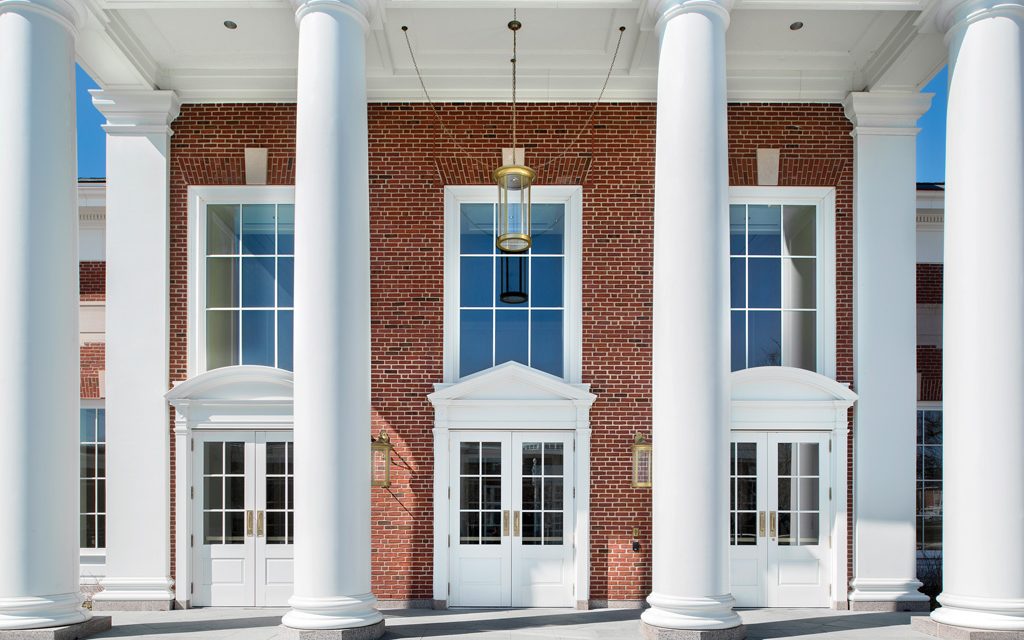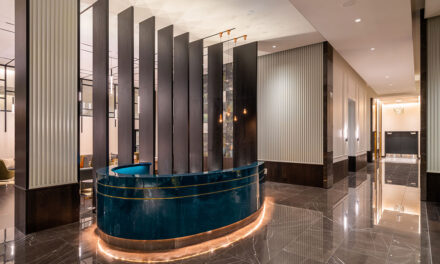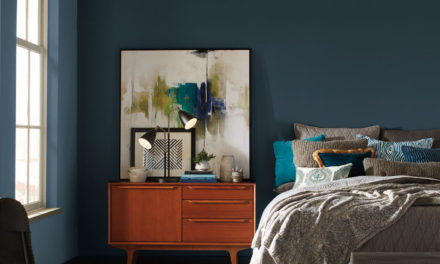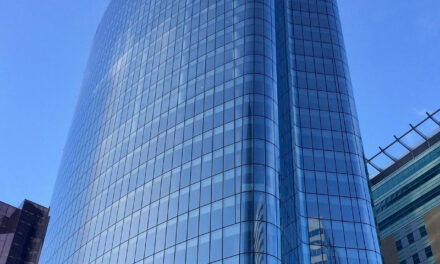(Wausau, Wisconsin) – Designed by Robert A.M. Stern Architects (RAMSA), DePauw University’s Hoover Hall provides a new dining hall for the Indiana university, while carrying forward the Georgian character of the campus and complementing the historic East College building. The $32 million project was completed on time, under budget and to meet U.S. Green Building Council’s LEED® Gold criteria.
Kolbe’s Ultra Series doors and Majesta® windows were key to meeting the new building’s aesthetics and sustainability goals. In addition, these same historically appropriate products updated the appearance and performance of Hoover Hall’s neighbor, the Memorial Student Union.
Connection, Contemplation, Creativity
For 175 years, DePauw University has offered a quality academic experience in a small-scale residential setting. Hoover Hall fulfills a core element of the University’s Campus Master Plan, which called for the transformation of the campus core into a place of greater connection, contemplation and creativity. Situated just north of Hanna Street along Burkhart Walk, Hoover Hall replaces the “Hub,” a food-court-style dining hall in the recently renovated Memorial Student Union Building.
Today, Hoover Hall serves as the primary dining space for first-year students and upper-class students living in University housing. Its new 48,600 square-foot facility seats more than 600 students in the main dining room, with dozens more accommodated in an array of smaller dining rooms. Here, faculty and students have the opportunity to extend classrooms lessons over mealtime discussions.
The building’s name honors R. David and Suzanne A. Hoover, both 1967 graduates of DePauw, who provided the lead gift to fund the building. The Hoovers, according to DePauw President D. Mark McCoy, “recognized that DePauw builds lifelong relationships through a strong sense of community. And that community needed a place to meet, to eat, to interact and to share.”
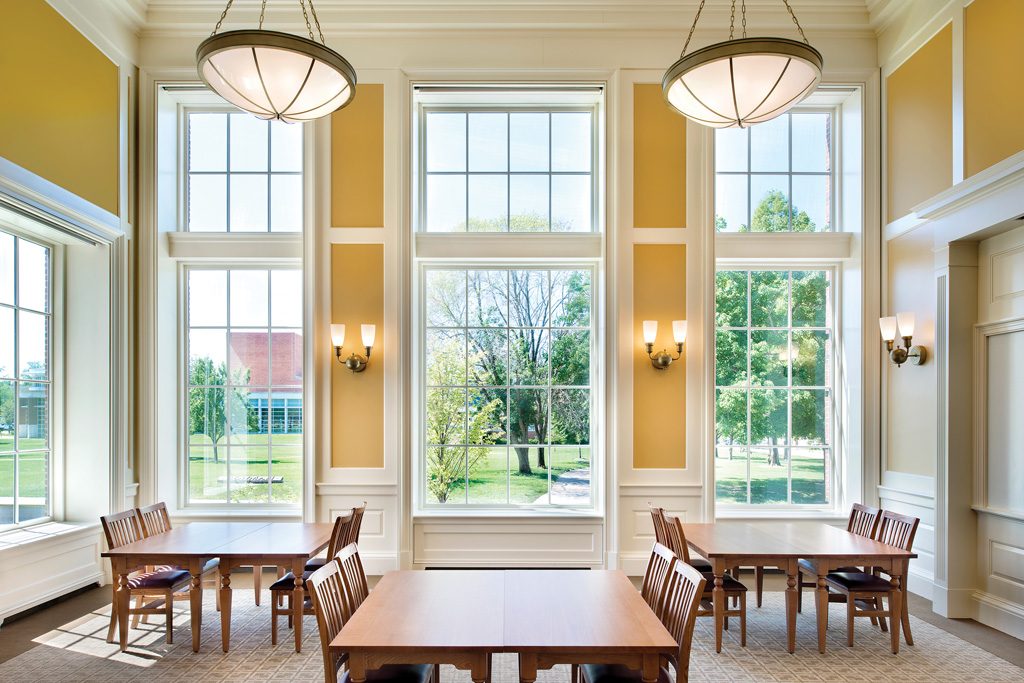
Credit: Daniel Showalter Photography, courtesy of Kolbe
Design Through Details
“When we went into the offices of Robert A.M. Stern in New York, it was really apparent, almost from the moment we entered, that they were genuinely excited about taking on this project,” said Suzanne Hoover. “They had all sorts of wonderful ideas for both form and function. This building has to work for its purpose, along with looking beautiful. So they brought all that to where we are today in this lovely facility.”
DePauw’s new dining hall maintains a traditional exterior, but its interior shifts from dated cafeteria lines in favor of exhibition-style cooking with a menu of foods from around the world. Designed in the Georgian style, popular between 1720 and 1830, it features steep-angled slate roofs with copper accents, hand-molded red brick, Indiana limestone and painted trim that blend with the rest of the campus.
“DePauw University’s Hoover Hall is designed in a restrained Georgian style, referencing the adjacent Memorial Student Union, as well as Asbury Hall and Harrison Hall, academic buildings to the north,” describes RAMSA Associate Sean Foley. “It was important to carry forward this design language through the details. Important aesthetic details for the windows include simulated divided lites, decorative brick mold trims, and custom color matching to the trim of the adjacent buildings.”
He continues, “Most importantly, the windows in Hoover Hall are very large, so that the activity within the building is visible and transparent from the surrounding quad and serves to draw students into the building.”
Foley emphasizes, “Not only was Kolbe Windows & Doors able to produce both the windows and exterior doors so that both components were complementary, they were able to produce the extremely large windows that our design required.”
The Right Option
Jason Harrison of Kenny Glass, the Indiana-based distributor of Kolbe Windows & Doors, worked closely with Turner Construction Company from the earliest stages of the project’s development. Together, they teamed with Kolbe to support the architectural vision of RAMSA, and exterior contractor JC Ripberger Construction to implement it.
“The architect wanted really, really large windows for this project, so we got Kolbe involved,” says Harrison. “What I like about Kolbe is that they don’t say ‘no’ right away; they look into it and see what’s possible. I really enjoyed working with Kolbe’s John Fenn and the Architectural Support team. They helped us find the right option that would meet the architect’s design.”
Kolbe’s team recommended a custom Ultra Series Majesta Double Hung Transom to match the look and sizes envisioned by RAMSA. Many of the windows’ frame dimensions span 85 by 118 inches. Harrison explains, “Because these are oversized, they’re also easier to service than direct sets, if the glass were to be broken and a replacement needed. When the idea of service-ability was introduced, the University really took note and was in favor of the custom Majesta Double Hung Transom.”
Curves and Constructability Challenges
“One of the more challenging aspects for us with the windows was perfecting the curved units that flank the main entrance,” says Jerry Morris of Turner Construction. “On the flat sash windows, simulated divided lites were specified and worked fine. On the curved units, simulated just weren’t possible, so Kolbe was able to modify their traditional design to match the desired look.”
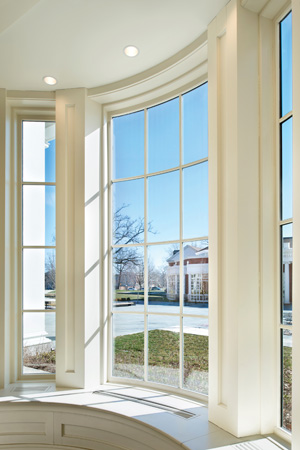
Credit: Daniel Showalter Photography, courtesy of Kolbe
Harrison elaborates, “At first, the radius was too sharp to produce. Kolbe kept making adjustments until they arrived at the right size and curvature that met the architect’s expectations. We actually ended up making these curved, flanking windows with PDLs [performance divided lites]. They’re almost exactly like the flat sash windows. The only difference is that curved glass cannot have grilles in the airspace. It was fun to see what Kolbe can do.”
“The University wanted to see how the windows were being crafted at Kolbe. Representatives from DePauw’s facility management team joined Turner and us for a tour at Kolbe’s Wisconsin headquarters,” says Harrison. “Kolbe walked us through their facility, showing us the process at every stage. Everyone was thoroughly impressed.”
Kolbe’s windows were crafted with PDLs segmenting the unit into nine lites with a 1-1/8-inch bar. The extruded aluminum clad exterior was finished in an Abalone color using a durable, 70 percent PVDF fluoropolymer coating. RAMSA also specified Low-E 270 glass with beveled glazing bead and Preserve.
Morris recollects, “Way up front, Kolbe was identified as a preferred vendor by RAMSA. Through the early discussions about the project, it was clear that they were the best choice for matching the architectural theme and needs for the building. Once the system was specified, we worked to create the detailed shop drawings and sample review to ensure the project’s constructability.”
Harrison says he and his team were “in talks with Turner for a year and a half before the windows were delivered.”
“It took several months to make sure each opening would be right, so that when the crew arrived on site everything would install as quickly and smoothly as possible,” acknowledges Morris. “From the perimeter fence to the wall of the building, we only had 20 feet. Every maneuver had to be planned. Given the size of the windows and confines of the site, that effort upfront made a difference.
Customized for Perfection
Another of the challenges posed to Kolbe for Hoover Hall was its brickmoulds. “Kolbe offers several extruded aluminum brickmould options, but the architect wanted something unlike any of these and drew a custom profile,” recalls Harrison. “RAMSA and Kolbe were extremely detailed in working together to make changes down to 1/16-inch to perfect it.”
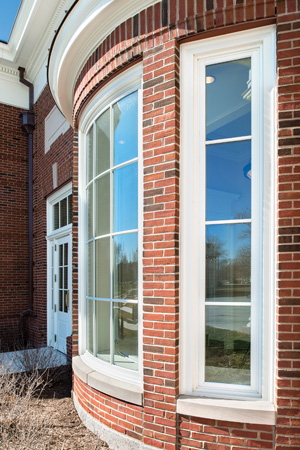
Credit: Daniel Showalter Photography, courtesy of Kolbe
Harrison adds, “The same custom brickmould used on Hoover Hall was used next door on the Memorial Student Union Building.” The Union also relied on Kolbe’s Ultra Series doors and Majesta windows to update its façade and match the new dining hall. The units not only have the same brickmould, they also have the same PDLs, glass and finish.”
“The project was designed to target a LEED Gold certification. A high-performing exterior envelope was key to achieving this,” explains Foley.
Kolbe also prepared all the doors with EPT (electric power transfer) to assist with their automation and installation. Harrison notes, “They routed grooves in the wood before the aluminum exteriors were applied to make the electrical connections as easy as possible.”
Morris adds, “Kolbe also matched the architectural style with its doors. There were about dozen 8-by-6 custom exterior doors in pairs plus a bunch of single ones. They were pre-hung, which was nice for the installation, too.”
Gratitude and Praise
The project broke ground on May 14, 2014. “The 29 months that followed have changed this campus forever,” said Melanie J. Norton, vice president of development and alumni engagement.
“Taking the vision of Hoover Hall to the reality of Hoover Hall was a considerable feat,” remarked Doug Smith, trustee and chairman of DePauw’s Buildings and Grounds Committee. “It involved assembling a team that understood the vision and could execute the plan on time and on budget. That was no easy task.”
Addressing those at the building’s dedication ceremony, Smith recognized RAMSA’s Sean Foley and Preston Gumberich “for their impressive interpretation of their vision and their passion for this project.” He said, “The firm is known for their ability to consistently design timeless structures that define the spaces where they’re built. Hopefully, when you walked up here today and looked at Hoover Hall, it felt like it had been here for a long time. The integration of this space into this campus core, I think they did a spectacular job of that. Their attention to detail is legendary.”
Smith also acknowledged Shane Hill and Jerry Morris of Turner Construction “for bringing those architectural drawings to life. They understood the magnitude of this project and demanded excellence from the team and the group of contractors they chose. Not only did they flawlessly execute the plan, but also, [did so] at 145,000 hours without any safety violations or injury – truly remarkable.”
Beyond the architect and general contractor, Smith was certain to praise “the more than 1,000 craftsmen and women who worked on this building… The artistry demonstrated in this hall was nothing short of amazing.”
Inclusive of DePauw’s internal contributions, Smith went on to thank all “those on campus who made the big part of their daily work shepherding this project to conclusion.” He gave special mention to Dick Vance, associate vice president of facilities, and Warren Whitesel, project manager.
Along with sharing his gratitude, Smith related a story of visiting Hoover Hall with its namesake in its final weeks of construction. “We had a little spring in our step because we were kind of excited to see what that façade looked like. As we rounded the corner of East College, you caught that façade for the first time. Dave literally stopped in his steps. It took his breath away. His vision had become a reality. At that point in time, you had two grown men about ready to cry – Dave for seeing that vision come to reality and myself very thankful for everybody who got us to this point today.”
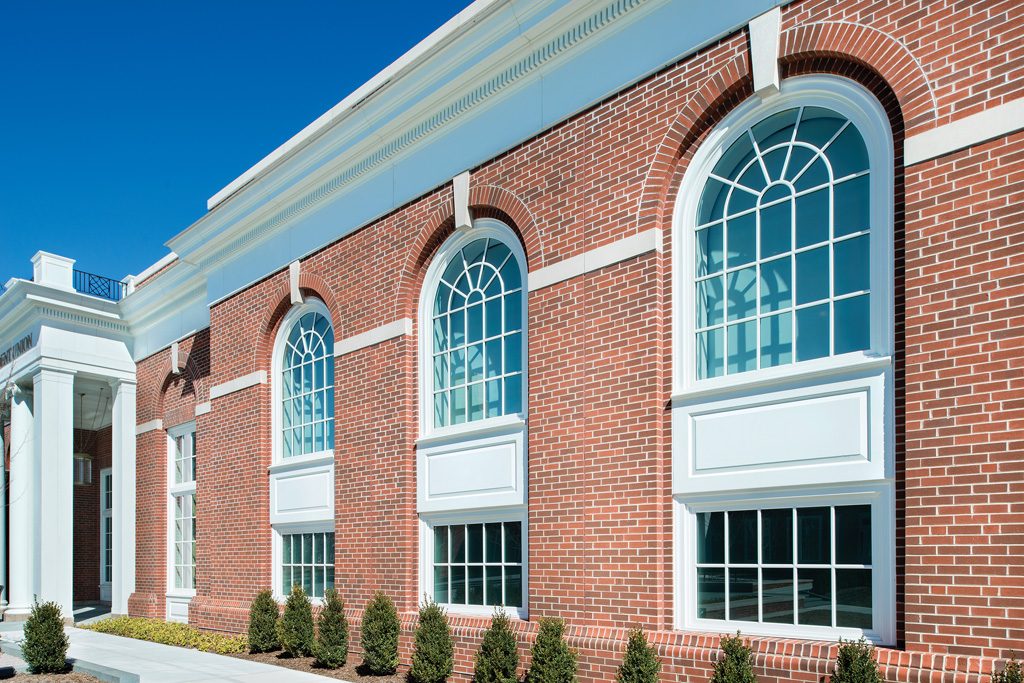
Credit: Daniel Showalter Photography, courtesy of Kolbe
Lifelong Relationships
Norton comments, “This magnificent building fills a purpose far beyond food or shelter, it invites a new heartbeat to the center of campus, and changes the way those who live and learn here will connect, interact and collaborate. It will feed us in ways beyond the obvious and its influence will be felt for generations to come.”
McCoy contemplated the building’s significance to these future students. He noted, “It is remarkable to think of the ways this building will shape DePauw. How many students, like Dave and Suzanne, will meet their lifelong companion within these walls? How many times will a professor start a conversation over a meal that completely changes the trajectory of a student’s life? How many friendships will be made and deepened here? How many problems solved? How many questions answered? How many imponderables will be pondered within these walls? Such moments are the fabric of the rich and rewarding DePauw experience, and now have a home, here in Hoover Hall. DePauw changes lives.”
David Hoover agreed and added, “It’s even better than we expected. We hope and expect it to be a place where people connect, communicate, build relationships, and improve and strengthen DePauw’s culture.”
McCoy concluded, “The beauty and magnificence of this space is clear to all of us and it will enhance the DePauw experience for the thousands of lives that will pass through these doors.”
DePauw University, 504 S. Indiana St., Greencastle, IN 46135; https://www.depauw.edu
• Architect: Robert A.M. Stern Architects LLP; New York; http://www.ramsa.com
• General contractor: Turner Construction Company; Indiana; http://www.turnerconstruction.com
• Exterior contractor: JC Ripberger Construction Corporation; Zionsville, Indiana; http://www.jcripberger.com
• Distributor: Kenny Glass, Inc.; Columbus, Indiana; http://www.kennyglass.com
• Manufacturer: Kolbe Windows & Doors; Wausau, Wisconsin; https://www.kolbewindows.com
• Photographer: Daniel Showalter Photography
• Video of Hoover Hall’s dedication: https://www.youtube.com/watch?v=D8pC105eATc
What began in 1946 as a two-brother team has grown into an internationally respected manufacturing company. Kolbe Windows & Doors is one of the nation’s leading manufacturers of windows and doors for residential and commercial markets. After more than 70 years, Kolbe products are best known for superior quality, custom craftsmanship, attention to detail, as well as innovative and unique designs.

